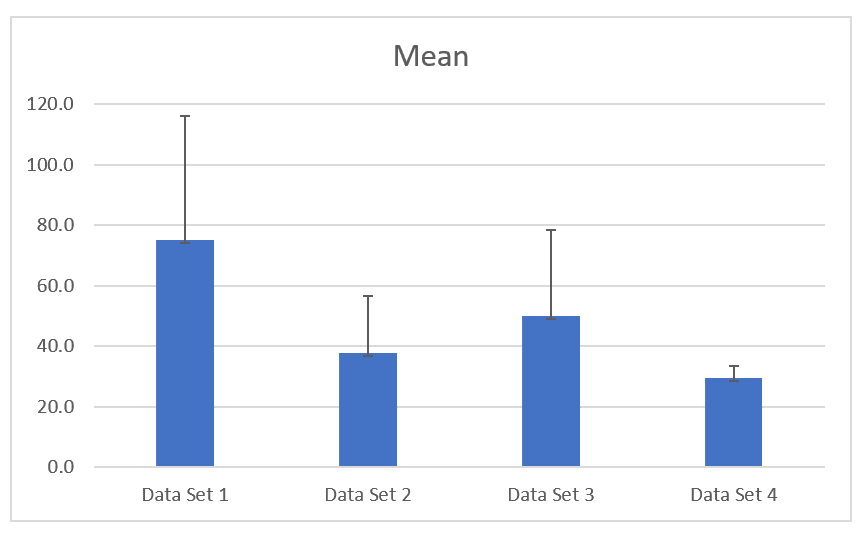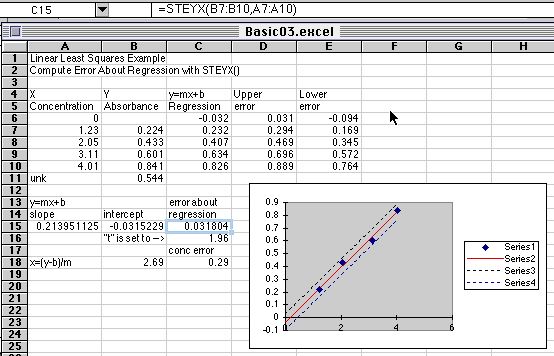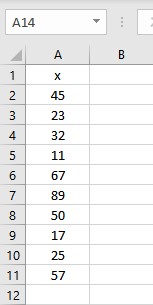
I do not know why Excel still does not include a formula for calculating the standard error of the mean. The formula would be different with a very large sample size. This is usually the case in physiology experiments.

Given the formula that Excel uses for calculation of standard deviation of the mean, this gives the standard error of the mean after adjusting for a small sample size. NOTE: We have calculated standard error of the mean by dividing the standard deviation of the mean by the square root of n. (This formula would calculate the standard error of the mean for numbers in cells A1 to A2.) Your formula in the formula bar should look something like this, “ =(STDEV(A1:A2))/(SQRT(COUNT(A1:A2)))”. The standard error of the mean should now show in the cell. Move the cursor to be between the 2 sets of parentheses, and type “SQRT”. Click on the spreadsheet picture in the pop-up box, and then highlight the list of numbers you averaged. Choose “Statistical” on the left hand menu, and then “COUNT” on the right hand menu.ħ. Put the cursor in the middle of the inner set of parentheses.Ħ. Put 2 sets of parentheses “(())” after the division symbol. Add a “/” sign to indicated you are dividing this standard deviation. Put a “(“ in front of STDEV and a “)” at the end of the formula. The t-quantile can be looked up for the level of confidence when the total sample size (n) and the number of. With the cursor still on the same cell, now click in the formula bar at the top of the spreadsheet (the white box next to the “=” sign) to put the cursor in that bar so you can edit the formula.ĥ. The formula can be solved for the SE: CI upper m + tSE -> SE (CI upper -m)/t. Hit enter, and “OK” to calculate the standard deviation.Ĥ. Click on the picture of the spreadsheet, and highlight the numbers you averaged earlier, just as you did when taking the average. Scroll down on the right hand side of the menu and select “STDEV” then click “OK”.ģ. Select “Stastical” from the left hand side of the menu, if necessary. A menu will appear that says “Paste Function”. Place the cursor in the cell where you wish the standard error of the mean to appear, and click on the f x symbol in the toolbar at the top.Ģ. This guide assumes you have already taken the average or mean.ġ.

Calculate standard error in excel how to#
You should perhaps use a Bayesian estimate or Wilson score interval.How to Calculate a Standard Error of the Mean in Excel How to use Excel NORM.INV Function: Calculate the inverse of Z score for the normal cumulative distribution for the pre-specified probability values using the NORM.INV function in Excel. Weighting by the inverse of the SEM is a common and sometimes optimal thing to do. Taking percentages the way you are is going to make analysis tricky even if they're generated by a Bernoulli process, because if you get a score of 20 and 0, you have infinite percentage. You don't have an estimate for the weights, which I'm assuming you want to take to be proportional to reliability. Where $x^* = \sum w_i x_i / \sum w_i$ is the weighted mean. In any case, the formula for variance (from which you calculate standard deviation in the normal way) with "reliability" weights is (Actually, all of this is rubbish-you really need to use a more sophisticated model of the process that is generating these numbers! You apparently do not have something that spits out Normally-distributed numbers, so characterizing the system with the standard deviation is not the right thing to do.) Instead, you need to use the last method.

You generate your data from frequencies, but it's not a simple matter of having 45 records of 3 and 15 records of 4 in your data set. In your case, it superficially looks like the weights are frequencies but they're not. you are just trying to avoid adding up your whole sum), if the weights are in fact the variance of each measurement, or if they're just some external values you impose on your data. In particular, you will get different answers if the weights are frequencies (i.e.

The key is to notice that it depends on what the weights mean. The formulae are available various places, including Wikipedia.


 0 kommentar(er)
0 kommentar(er)
